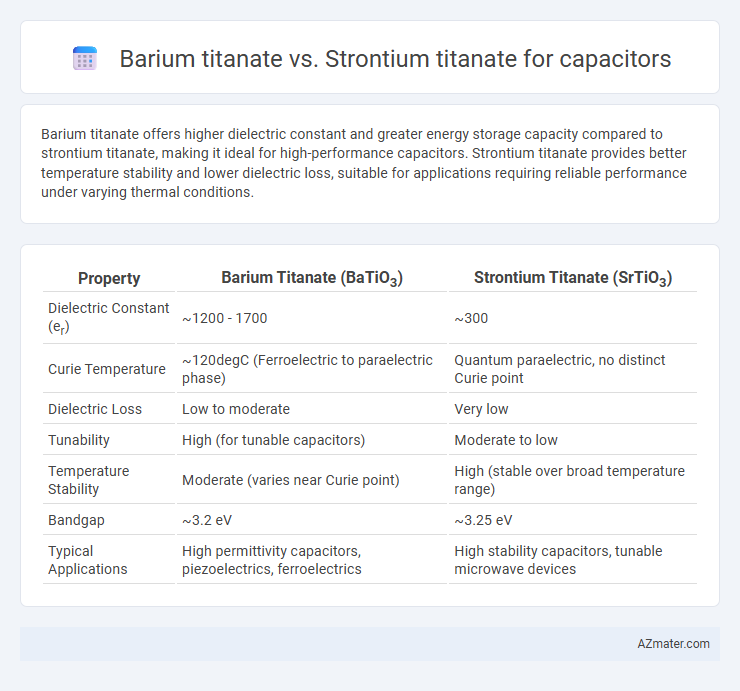Barium titanate offers higher dielectric constant and greater energy storage capacity compared to strontium titanate, making it ideal for high-performance capacitors. Strontium titanate provides better temperature stability and lower dielectric loss, suitable for applications requiring reliable performance under varying thermal conditions.
Table of Comparison
| Property | Barium Titanate (BaTiO3) | Strontium Titanate (SrTiO3) |
|---|---|---|
| Dielectric Constant (er) | ~1200 - 1700 | ~300 |
| Curie Temperature | ~120degC (Ferroelectric to paraelectric phase) | Quantum paraelectric, no distinct Curie point |
| Dielectric Loss | Low to moderate | Very low |
| Tunability | High (for tunable capacitors) | Moderate to low |
| Temperature Stability | Moderate (varies near Curie point) | High (stable over broad temperature range) |
| Bandgap | ~3.2 eV | ~3.25 eV |
| Typical Applications | High permittivity capacitors, piezoelectrics, ferroelectrics | High stability capacitors, tunable microwave devices |
Introduction to Ceramic Capacitors
Barium titanate (BaTiO3) and strontium titanate (SrTiO3) are key ferroelectric materials used in ceramic capacitors, valued for their high dielectric constants and temperature stability. Barium titanate offers superior dielectric permittivity, making it ideal for multilayer ceramic capacitors (MLCCs) in high-capacitance applications, while strontium titanate provides improved dielectric losses and better performance at elevated temperatures. The choice between these titanates affects the capacitor's efficiency, frequency response, and thermal reliability in electronic circuits.
Material Overview: Barium Titanate vs Strontium Titanate
Barium titanate (BaTiO3) exhibits a high dielectric constant and strong ferroelectric properties, making it ideal for high-performance multilayer ceramic capacitors (MLCCs) with excellent energy storage capabilities. Strontium titanate (SrTiO3) offers a lower dielectric constant but superior temperature stability and lower dielectric loss, enhancing capacitor reliability in variable thermal environments. The crystal structure differences--BaTiO3's tetragonal versus SrTiO3's cubic perovskite lattice--directly impact their polarization behavior and suitability for specific capacitor applications.
Dielectric Constant Comparison
Barium titanate (BaTiO3) exhibits a higher dielectric constant, typically ranging from 1,000 to 7,000, which makes it exceptionally suitable for high-capacitance ceramic capacitors. Strontium titanate (SrTiO3) has a lower dielectric constant, generally around 300 to 400, offering stability but less capacitance density compared to BaTiO3. The superior dielectric permittivity of barium titanate enhances energy storage efficiency, while strontium titanate's lower losses provide benefits in applications requiring temperature stability.
Temperature Stability and Performance
Barium titanate exhibits high dielectric constant but suffers from significant temperature-dependent permittivity changes, limiting its stability in capacitors across broad temperature ranges. Strontium titanate offers superior temperature stability with a lower dielectric constant, making it more reliable in applications requiring consistent capacitance under thermal variations. The choice between barium titanate and strontium titanate balances dielectric performance against temperature stability for optimized capacitor functionality.
Frequency Response Characteristics
Barium titanate exhibits high dielectric constant and strong ferroelectric properties, making it ideal for capacitors operating at low to mid frequencies with excellent charge storage capabilities. Strontium titanate offers superior dielectric stability and lower dielectric loss across a wider frequency range, particularly at high frequencies, ensuring consistent performance in RF and microwave applications. The frequency response of barium titanate capacitors tends to decrease with increasing frequency, while strontium titanate maintains stable permittivity, making it better suited for high-frequency capacitors.
Energy Storage Capabilities
Barium titanate exhibits high dielectric constant and strong ferroelectric properties, making it highly effective for energy storage in capacitors. Strontium titanate offers lower dielectric permittivity but provides excellent dielectric tunability and stability under high electric fields. For energy storage applications, barium titanate capacitors store more energy due to higher polarization, while strontium titanate capacitors perform better in applications requiring temperature stability and low dielectric loss.
Manufacturing Processes and Cost
Barium titanate is widely used in capacitor manufacturing due to its high dielectric constant and ease of sintering, allowing for efficient mass production with well-established ceramic processing techniques. Strontium titanate, while offering superior temperature stability and lower dielectric loss, typically requires more complex and costly synthesis methods such as high-purity powder preparation and controlled atmosphere sintering, increasing overall production expenses. The cost-effectiveness of barium titanate makes it the preferred choice for commercial multilayer ceramic capacitors, whereas strontium titanate is favored in niche applications demanding high performance despite higher manufacturing costs.
Applications in Modern Electronics
Barium titanate exhibits excellent dielectric properties and high permittivity, making it ideal for multilayer ceramic capacitors (MLCCs) used in smartphones, automotive electronics, and industrial sensors. Strontium titanate, with its tunable dielectric constant and compatibility with high-frequency applications, is preferred in tunable capacitors, microwave devices, and advanced communication systems. Both materials enhance capacitor performance in modern electronics, but barium titanate dominates in high-capacitance, low-loss applications while strontium titanate excels where variable capacitance and thermal stability are critical.
Reliability and Longevity
Barium titanate exhibits higher dielectric constants and better temperature stability, which contribute to excellent reliability in capacitors under varying operating conditions. Strontium titanate offers lower dielectric losses and improved longevity due to its resistance to aging and fatigue in high-frequency applications. Both materials enable durable capacitors, but barium titanate is favored for stability while strontium titanate excels in long-term performance.
Future Trends in Capacitor Materials
Barium titanate and strontium titanate remain pivotal in advancing capacitor technology due to their high dielectric constants and tunable permittivity. Future trends emphasize optimizing these perovskite oxides for enhanced energy storage density, temperature stability, and miniaturization in multilayer ceramic capacitors (MLCCs). Research increasingly focuses on doping strategies and nano-structuring to tailor their electrical properties, aiming to meet the demands of next-generation electronics and electric vehicles.

Infographic: Barium titanate vs Strontium titanate for Capacitor
 azmater.com
azmater.com